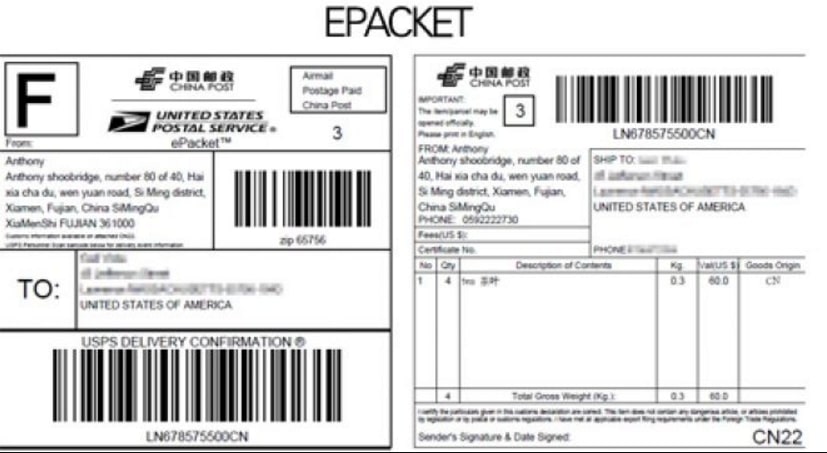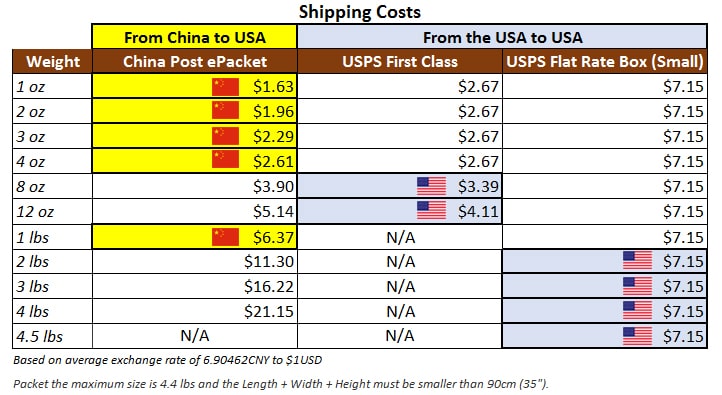Update June 8, 2020 – The rate increases to occur over the next 5 years have been announced (see below).
Update September 25, 2019: The U.S. and United Nations reached a deal that would keep America in the Universal Postal Union in return for more flexibility in setting their own postal rates.
Update October 2018: The Trump administration has announced plans to pull out of the Universal Postal Union which would effectively end ePacket.
For many years, sellers in China have been able to ship for less from China to America than local American sellers can domestically, thanks to something called ePacket. In September 2019 this was all set to change, however, as the Universal Postal Union and the United States reached a deal that will allow countries to set rates for individual countries more freely.
Is this the end of ePacket and cheap shipping from China? Continue reading to understand the history of ePacket and understand whether it’s the end of cheap shipping from China.
The Background – In 2010, USPS Makes a Deal with China Post/Hong Kong Post
In 2010-2011, USPS entered into an agreement with Hong Kong Post and China Post that came into effect in 2011 to offer a shipping option called “ePacket”. What an ePacket basically boils down to is that merchants in Hong Kong and mainland China could now ship packages up to 4.4 lbs, with tracking and 7-10 business day delivery times. But here’s the kicker – shipping a package from China to the U.S. is about $1 cheaper than from within the United States. That’s not a typo. It’s $1 cheaper to ship from China to the USA than from the USA to the USA.
USPS reports its loses, on average, to be $1.10 for each package it delivers from China. In fact, in 2014 USPS reported that they lost over $75 million delivering foreign mail. U.S. congress held meetings regarding the subject in 2015.
So why would USPS make such a stupid agreement? Well, it’s not necessarily USPS’s fault. USPS is bound by an agreement with the Universal Postal Union (ever heard of it? Me neither). The Universal Postal Union (UPU) is one of the oldest international organizations in the world dating back to the 19th century. Its original goal was to allow people and businesses to mail letters for a flat rate anywhere in the world and it also helps subsidize poorer countries’ mail delivery. Seems well-intentioned right? Well, then ecommerce happened.
The UPU has fallen behind on times and hasn’t adjusted for the sudden surge in ecommerce or China’s newfound wealth and unfortunately, nothing is changing for at least a couple of years (see below for what may change in the future and what you can do in the meantime).
The agreement USPS made with China for ePacket wasn’t that stupid. USPS actually loses less money with ePacket than if Chinese suppliers shipped with regular mail and the rates set by the UPU. However, ePacket provides exceptional tracking and delivery times – two critical demands of ecommerce consumers. Without ePacket, the total volume of packages coming from Chinese suppliers would almost certainly be lower.
A Double Whammy – De Minimis Raised in 2016 to $800
But, wait. There’s more!
Not only do Chinese suppliers get the benefit of shipping for cheaper than you can, but they also get to ship their products to consumers duty-free.
In 2016, the U.S. raised the de minimis value up to $800. This means any package shipped under $800 to the United States gets to enter duty-free. So while other Chinese suppliers can ship to other countries like Canada with reduced shipping rates the same way they would to the U.S., the de minimis value in Canada is closer to $100 meaning consumers get hit with annoying duties and taxes upon delivery for anything over this amount.
September 2019 – The U.N. and U.S. Reach a Deal
On September 25, 2019, the United States and United Nations reached a deal for America to stay in the UPU in return for being allowed greater flexibility in setting prices. In other words, the U.S. can now set rates for mail from China and other countries. The U.S. will be allowed to set its own postal rates starting on July 2020 and other countries will be allowed to starting in 2021. There will be a five-year period of phasing in new rates.
The maximum annual increases for all countries cumulatively from 2020 to 2025 will be between 119%-164% (with China being on the upper end). This works out to annual increases of 15% in 2021 and 2022, 16% in 2023 and 2024, and 17% in 2025.
China Post ePacket vs USPS Rates
So here’s what most of you care about: what does it cost to ship an item from China compared to from within the U.S.? Below are the approximate rates (for USPS I calculated shipping an item from Washington State to Florida).
You can see from the above anything under 4 ounces is actually cheaper to ship from China. From 4 ounces to 8 ounces the rates are pretty comparable. Once you start hitting about 2 lbs, the prices from shipping within the U.S. start to get comparatively cheaper and cheaper than shipping from within China.
Is This the End of ePacket and Cheap Shipping from China?
It remains to be seen how much postal rates will increase from China. The chances are good it will be quite significant and it may be part of a larger U.S.-China trade deal. However, new postal rates won’t kick in until July 2020 and they will gradually be phased in over five years. In other words, don’t expect cheap China shipping to disappear overnight.
What Should You Do Until ePacket is Eliminated?
Until ePacket and cheap China shipping get eliminated, here are some steps to take:
- Avoid undifferentiated items under 1 lb
- Try to avoid undifferentiated items from 1 to 4.4 lbs
- Avoid items under 4.4 lbs that are not fulfilled by Amazon
If you’re selling undifferentiated items (cell phone accessories, small electronics, hair extensions, etc) that weigh under 4.4 lbs, in the long run it will be next to impossible to compete with Chinese suppliers (at least if you don’t use Amazon FBA). I personally know of a Chinese supplier in Beijing running a multi-million dollar ecommerce business targeted to Americans with a massive warehouse just outside of Beijing. They employ, as they describe it, ‘an army of peasants’ to do all of their order fulfillment. You can’t compete with this: they pay less in shipping rates and less in staffing and fulfillment costs.
Who Wins If ePacket is Eliminated?
If ePacket and cheap China shipping are eliminated the big winners are going to be any North American sellers who compete against Chinese sellers shipping directly from China. This means anyone selling small and light items is likely going to see a slight boost to their business.
Stock holding sellers will also get one more advantage over dropshippers. This also likely is going to help Amazon somewhat as it will severely hurt competitors like Aliexpress and Wish.com.
The big losers are going to be said Chinese sellers as well as anyone who dropships from China. Dropshipping from China was a burgeoning industry even in America and it’s driving the nail in the dropshipping coffin a little bit deeper.
Conclusion
ePacket and cheap China shipping still exist for the time being. How much rates will go up when shipping from China remains to be seen.
If and when rates do go up significantly, those selling small and light items are likely to have a small bonanza thanks to the elimination of many of their Chinese counterparts.
Do you think the new deal that the United States has struck with the Universal Postal Union will be a boon for American sellers? Or do you think the Chinese will still find a way to gain an upper hand?
Dave Bryant has been importing from China for over 10 years and has started numerous product brands. He sold his multi-million dollar ecommerce business in 2016 and create another 7-figure business within 18 months. He’s also a former Amazon warehouse employee of one week.
from Hacker News https://ift.tt/2mIggef


No comments:
Post a Comment
Note: Only a member of this blog may post a comment.